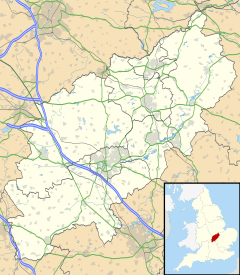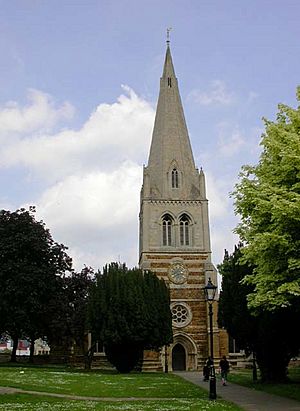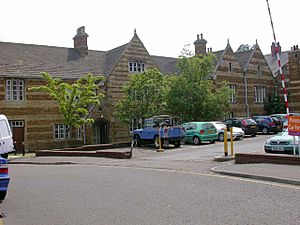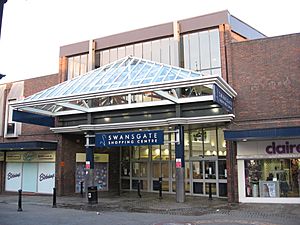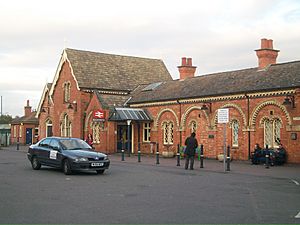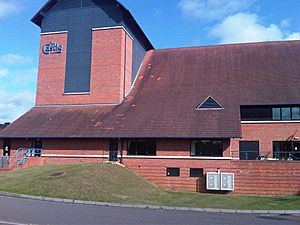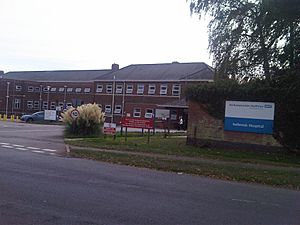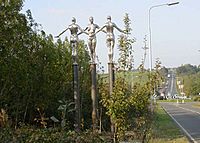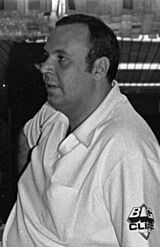Wellingborough facts for kids
Quick facts for kids Wellingborough |
|
|---|---|
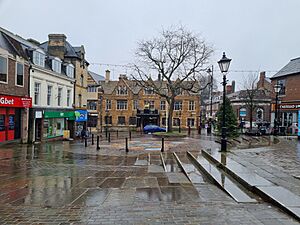 Wellingborough Town Centre |
|
| Population | 56,564 (2021 Census) |
| Demonym | Wellingburian |
| OS grid reference | SP8967 |
| • London | 65 miles (105 km) |
| Unitary authority |
|
| Ceremonial county | |
| Region | |
| Country | England |
| Sovereign state | United Kingdom |
| Post town | WELLINGBOROUGH |
| Postcode district | NN8 NN9 |
| Dialling code | 01933 |
| Police | Northamptonshire |
| Fire | Northamptonshire |
| Ambulance | East Midlands |
| EU Parliament | East Midlands |
| UK Parliament |
|
Wellingborough (/ˈwɛlɪŋbrə/ wel-ING-brə) is a market town and civil parish in North Northamptonshire, England. It is about 65 miles (105 km) from London and 11 miles (18 km) from Northampton. The town is located north of the River Nene.
This area was first settled by the Anglo-Saxon people. They called it "Wendelingburgh," which meant "the stronghold of Wændel's people." The town is even mentioned in the Domesday Book of 1086 as "Wendelburie." Wellingborough was given permission to hold a market in 1201 by King John. In 2021, the town had a population of 56,564 people. Some nearby areas like Wilby and Great Doddington are also part of Wellingborough's built-up area.
Contents
- Discovering Wellingborough's Past
- How Wellingborough is Governed
- Wellingborough's Location and Environment
- Wellingborough's Population and Homes
- Wellingborough's Economy and Future
- Getting Around Wellingborough
- Learning in Wellingborough
- Wellingborough's Culture and Fun
- Sports in Wellingborough
- Health Services in Wellingborough
- Important Places to See
- Famous People from Wellingborough
- Sister Cities
- See also
Discovering Wellingborough's Past
Wellingborough began in the Anglo-Saxon period. It was known as "Wendelingburgh" back then. The town is surrounded by five special wells: Redwell, Hemmingwell, Witche's Well, Lady's Well, and Whytewell. You can even see these wells on the town's coat of arms. In 1627, Henrietta Maria, who was the Queen Consort of King Charles I, visited Wellingborough with her doctor to try the waters from these wells.
The town also had a small monastic grange during the Middle Ages. This was like a farm owned by monks. Today, it's the Jacobean Croyland Abbey. It was connected to Crowland Abbey near Peterborough. This part of town is still called Croyland.
All Hallows Church is the oldest building still standing in Wellingborough. It was built around 1160. Monks from Crowland Abbey likely built the first church. The oldest part of the church is a Norman doorway. The church grew over time with more chapels. Its tall west tower, which is 160 feet (49 m) high, was finished around 1270.
Wellingborough received its Market Charter on April 3, 1201. King John allowed the monks of Croyland Abbey to hold a market every Wednesday.
During the time of Queen Elizabeth I, Sir Christopher Hatton was a powerful local lord. He helped fund the trips of Sir Francis Drake. Drake even renamed one of his ships, the Golden Hind, after the Hatton family's symbol. A hotel in Wellingborough, built in the 1600s, was later called the Golden Hind Hotel.
During the English Civil War, a small fight happened in Wellingborough. A Parliament officer was killed, and some people from the town were taken away. After the war, a group called the Diggers lived in Wellingborough for a short time.
Wellingborough was bombed during World War II on August 3, 1942. Six people died and 55 were hurt. Many buildings in the town center were damaged.
The town once had two railway stations. The first, Wellingborough London Road, opened in 1845 but closed in 1966. The second, Wellingborough Midland Road, opened in 1857 and is still used today. It connects Wellingborough to London and other places. In 1898, a train accident near Wellingborough killed several people and injured many more.
How Wellingborough is Governed
Wellingborough is now part of a larger local government area called North Northamptonshire. This is a unitary authority, which means it handles all local services. Before 2021, Wellingborough had its own council, the Borough Council of Wellingborough.
In April 2021, the old Borough of Wellingborough was replaced. Now, North Northamptonshire covers Wellingborough and other nearby areas like Corby and Kettering.
Wellingborough also has its own civil parish and a new Town Council. This means local people have a say in town matters. Wellingborough also has a mayor.
The town is part of the Wellingborough Constituency for the UK Parliament. This area includes the town and surrounding villages. The current Member of Parliament (MP) for Wellingborough is Gen Kitchen. In 1918, Wellingborough became the first area in southern England outside London to elect an MP from the Labour Party.
Wellingborough's Location and Environment
Town's Natural Setting
Wellingborough is built on hills next to the River Nene. In the Middle Ages, this was a good spot for farming. The area has different types of soil, from fertile valley soils to heavier clay soils on the hills.
Iron Ore Mining
A very important part of Wellingborough's natural resources was its Northampton Sands ironstone formation. This rock contains iron. For a long time, it was hard to use this iron because it had a lot of phosphorus. But new methods, like the Bessemer process, made it possible to turn this iron into high-quality steel. This iron was very important for the United Kingdom before World War II.
Mining for iron ore was a big industry in Wellingborough from the 1860s to the 1960s. Large ironworks were built, and special narrow gauge railways, called tramways, were used to carry the iron ore.
Weather in Wellingborough
Wellingborough has an oceanic climate, which is typical for most of the British Isles. This means it has mild winters and cool summers, with rain throughout the year.
| Climate data for Wellingborough, GBR | |||||||||||||
|---|---|---|---|---|---|---|---|---|---|---|---|---|---|
| Month | Jan | Feb | Mar | Apr | May | Jun | Jul | Aug | Sep | Oct | Nov | Dec | Year |
| Record high °C (°F) | 13 (55) |
14 (57) |
17 (63) |
20 (68) |
24 (75) |
27 (81) |
29 (84) |
31 (88) |
24 (75) |
23 (73) |
17 (63) |
14 (57) |
31 (88) |
| Mean daily maximum °C (°F) | 7 (45) |
8 (46) |
11 (52) |
13 (55) |
17 (63) |
19 (66) |
22 (72) |
23 (73) |
19 (66) |
14 (57) |
10 (50) |
7 (45) |
14 (58) |
| Mean daily minimum °C (°F) | 2 (36) |
2 (36) |
4 (39) |
4 (39) |
7 (45) |
10 (50) |
12 (54) |
12 (54) |
10 (50) |
8 (46) |
5 (41) |
3 (37) |
7 (44) |
| Record low °C (°F) | −15 (5) |
−13 (9) |
−8 (18) |
−5 (23) |
−1 (30) |
2 (36) |
6 (43) |
5 (41) |
4 (39) |
−3 (27) |
−10 (14) |
−14 (7) |
−15 (5) |
| Average precipitation cm (inches) | 4.51 (1.78) |
3.39 (1.33) |
2.87 (1.13) |
4.39 (1.73) |
3.49 (1.37) |
4.66 (1.83) |
4.21 (1.66) |
4.69 (1.85) |
5.49 (2.16) |
5.68 (2.24) |
4.8 (1.9) |
4.98 (1.96) |
53.16 (20.94) |
Nearby Towns and Cities
Wellingborough is close to towns like Northampton, Rushden, and Higham Ferrers.
 |
Hardwick, Birmingham | Great Harrowden, Kettering, Market Harborough, Leicester | Finedon, Peterborough, Stamford |  |
| Mears Ashby, Sywell, Rugby | Irthlingborough, Higham Ferrers, Rushden, Cambridge | |||
| Great Doddington, Earls Barton, Northampton, Buckingham, Wilby | Wollaston, Milton Keynes | Irchester, Rushden, Bedford, Luton, London |
Wellingborough's Population and Homes
Wellingborough's population grew quickly in the 1960s and 1970s. This happened because agreements were made to re-house people from London who needed homes. After World War II, many people from the Commonwealth of Nations moved to Britain. Because of this, a large Black Caribbean and Indian/Pakistani community grew in Wellingborough. Today, these groups make up 11% of the town's population.
Housing Areas
Wellingborough has several public housing estates. These include Hemmingwell, Queensway, and Kingsway. Many of these areas were built to provide homes for people moving from London. There are also smaller housing areas like Spring Gardens. These estates are home to a large number of Wellingborough residents.
Wellingborough's Economy and Future
Wellingborough has about 2,500 businesses. The town center was rebuilt in the 1970s when the town grew quickly. The local council has plans to improve the town center even more. In the past, Wellingborough was known for making shoes and engineering. Now, it has many different types of businesses, including logistics (moving goods) and service industries.
As a market town, Wellingborough has many well-known shops in its town center. The main shopping center is Swansgate, which used to be called the Arndale Centre. It was built in the 1970s. The town also has retail parks and supermarkets outside the center. Wellingborough holds a market three times a week.
Other businesses in town include motorsport, engineering, and technology companies. Big companies like Cummins UK and Comet have offices here. There are several industrial areas in Wellingborough, such as Park Farm and Denington.
Future Plans for the Town
The government has plans for Wellingborough to grow a lot in the next 30 years. This includes building 12,800 new homes and creating 12,400 new jobs. The town center will also be improved, and new facilities will be added.
Plans are being made for a large new development called 'Stanton Cross' on the east side of the railway station. This project will add 3,200 new homes, new schools, shops, a doctor's office, and parks.
The railway station will also be updated. It will become an 'interchange' where people can easily switch between local buses and trains. A new platform, footbridge, and station buildings are planned. A new road bridge over the railway line is also part of the plans.
In 2021, work started on a new housing development near Park Farm. This project will build 600 homes, including affordable housing, and will also include facilities for education, health, and sports.
Getting Around Wellingborough
The A45 dual carriageway runs south of the town. It connects Wellingborough to major roads like the A14 and M1. These roads help people travel across the country. The A45 also links Wellingborough to nearby towns like Northampton and Rushden.
Buses in Wellingborough are run by Stagecoach in Northants and Centrebus. Local buses connect the town center to different neighborhoods and villages. The X4 bus service runs every 30 minutes and links Wellingborough to Milton Keynes, Northampton, and Peterborough.
East Midlands Railway operates direct trains from Wellingborough railway station to London St Pancras International. These trains leave every 30 minutes and take about 55 minutes to reach London. The railway also connects Wellingborough to cities like Leicester, Nottingham, and Sheffield.
Several UK airports are within a two-hour drive of Wellingborough. These include London Luton, East Midlands, and London Stansted. You can reach Luton directly by train. Sywell Aerodrome, a smaller airport, is just 5 miles away and is used for private flights and flight training.
Learning in Wellingborough
Wellingborough has many primary schools that prepare students for secondary schools. The main secondary schools are Sir Christopher Hatton Academy, Weavers Academy, and Wrenn School. There is also Wellingborough School, which is an independent school where students pay fees.
Tresham College of Further and Higher Education has a campus in Wellingborough. It offers courses for students who want to continue their education after school. The college also works with universities to offer higher education options.
The University of Northampton is in nearby Northampton. It has about 10,000 students and offers many different courses, from arts and sciences to business and design.
Cadet Groups
Wellingborough is home to a branch of the Army Cadet Force. It also has its own Air Cadet Squadron, called 378 (Mannock) Squadron. This squadron is special because it's named after a person, Mick Mannock, instead of a place.
Wellingborough's Culture and Fun
The Castle Theatre opened in 1995. It's not just a theater; it also has many facilities for local people. Groups like the Castle Youth Theatre use the rooms daily.
Wellingborough has a public library in the market square. The Wellingborough Museum is next to The Castle Theatre. It shows the history of Wellingborough and nearby villages. The museum is in an old Victorian swimming pool building from 1892. It was a shoe factory for many years before becoming a museum. The museum has a gift shop and a café.
Local Media
Local news and TV shows for Wellingborough come from BBC East and ITV Anglia.
The town's local radio stations include BBC Radio Northampton (104.2 FM), Heart East (96.6 FM), and Smooth East Midlands (97.2 FM).
Local newspapers are the Northampton Herald & Post and Northamptonshire Telegraph.
Sports in Wellingborough
Wellingborough has two football clubs: Wellingborough Town and Wellingborough Whitworth.
In 2009, the town's rugby club was the first in the East Midlands to receive a special award from the RFU (Rugby Football Union). Harrowden Hall, a 17th-century building just outside town, is the clubhouse for a private golf course. Wellingborough also has several leisure centers and health clubs, including Redwell and Waendel.
The Waendel Leisure Centre is the main council-owned sports center. It has a six-lane, 25-meter swimming pool, which is used for training by the Wellingborough Amateur Swimming Club. The center also has a smaller, shallow pool for learning to swim. Waendel also has a newly updated gym.
Wellingborough Phoenix is one of the largest basketball clubs in the UK. Its men's and women's teams play in national leagues. Youth teams also play in national leagues.
Every May, Wellingborough hosts the annual Waendel Walk. This is a non-competitive walking event with different routes through the countryside. It's part of the International Marching League.
Health Services in Wellingborough
Several NHS centers provide healthcare in Wellingborough. Isebrook Hospital can do things like large X-rays and special tests for nerves. For emergencies, maternity care, and surgeries, people usually go to Kettering General Hospital. The Air Ambulance service for the area is provided by Warwickshire and Northamptonshire Air Ambulance.
Five Wells Prison is also located in Wellingborough.
Important Places to See
The railway station is a Grade II listed building, which means it's a historically important building. Another important building is the All Hallows Church, which has a 600-year-old steeple.
The Three Silver Ladies is a sculpture on Harrowden Road. It represents the local Roman history, the river, and the townspeople working together.
To the west of the town center is the Roman Catholic Our Lady of the Sacred Heart Church. Experts say it has "highly original details" and a "lavishly finished interior."
Famous People from Wellingborough
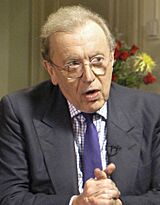
- Sir Paul Pindar (1565–1650), an important ambassador for King James I.
- William Bull (1738–1814), a religious leader.
- John Clarke (1761–1815), a doctor who specialized in childbirth.
- John Askham (1825–1894), a poet who published five books of poems.
- Harry Crane Perrin (1865–1953), an organist at Canterbury Cathedral.
- Alfred Dobbs (1882–1945), a politician and trade union leader.
- Kenneth Mees (1882–1960), a scientist who researched photography.
- F. H. Gravely (1885–1965), an expert on spiders.
- Arthur Allen (1887–1981), a shoe manufacturer, trade unionist, and politician.
- Mick Mannock (1887–1918), a famous RAF pilot and war hero.
- Sir David Frost (1939–2013), a well-known broadcaster.
- Brian Binley (1942–2020), a politician and local MP.
- Bruce Quarrie (1947–2004), a writer on wargaming.
- Stephen Elboz (born 1956), a writer of children's books.
- Jim Murray (born 1957), a writer and expert on whisky.
- Peter Murphy (born 1957), the lead singer of the band Bauhaus.
- Thom Yorke (born 1968), the lead singer and songwriter of the band Radiohead.
- Tom Pursglove (born 1988), a politician who grew up in the area.
- Daniel Robert Middleton (born 1991), a famous YouTuber and gamer.
Sports Stars
- Bill Perkins (1876-ca 1940), a football goalkeeper.
- Fanny Walden (1888–1949), a footballer.
- Billy Brawn (1878–1932), a footballer.
- Jeff Butterfield (1929–2004), a rugby player for England.
- Brian Hill (born 1947), a football referee.
- Anita Neil (born 1950), the first Black British woman to compete in the Olympics.
- Cliff Lazarenko (born 1952), a darts player.
- Marc Iliffe (1972–2003), a strongman.
- Peter Ebdon (born 1970), a snooker player.
- Rory McLeod (born 1971), a snooker player.
- Trevor Benjamin (born 1979), a footballer.
Sister Cities
Wellingborough has special connections with other towns around the world. This is called town twinning.
- Niort, France (since 1977)
- Wittlich, Germany
Wellingborough also has a friendly relationship with Willingboro, a town in Burlington County, New Jersey, United States.
See also
 In Spanish: Wellingborough para niños
In Spanish: Wellingborough para niños


